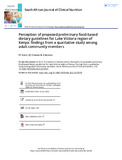| dc.description.abstract | Background: Diets in the Lake Victoria region of Kenya have been described as monotonous, consisting chiefly of starchy staple foods, accompanied by green vegetables and oil. To promote healthy eating in the region, 11 food-based dietary guidelines (FBDGs) were proposed. Objective: This study was designed to assess perception of the proposed FBDGs amongst consumers in Lake Victoria region. Design and setting: A qualitative, descriptive cross-sectional design was used to collect data from 36 focus-group discussions (FGD) among adult males (18) and females (18) in Kisumu and Homa Bay Counties. Subjects: A total of 207 adult males (26–74 years) and 211 females (18–71 years) participated in this study. Data collection and analysis: Proposed FBDGs were printed on posters and presented to FGD participants. Proceedings were audio-taped, transcribed, translated and analysed based on themes. Results: The proposed FBDGs were perceived as promoting the consumption of a balanced diet. As a concept, a balanced diet was misrepresented as composed of only three nutrients: carbohydrates, proteins and vitamins. There was no mention of fats/ oils and minerals as other significant nutrient constituents of a balanced diet. Other concepts, which included ‘three regular meals’, ‘snacks’, ‘food variety’, ‘healthy and physically active lifestyle’, were polysemous. Conclusion: The findings provide insight to guide the adaptation of the national FBDGs. The findings also provide a basis for nutrition advocacy programmes and a rationale for the revision of nutrition education materials, including the school curriculum, to align content with current evidence-based information. | en_US |

